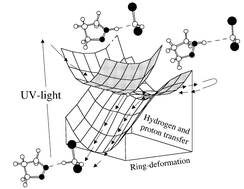Excited state quenching via “unsuccessful” chemical reactions†
Abstract
We discuss the results of recent photochemical reaction path computations on 1n,π* azoalkanes interacting with a single quencher molecule. We provide computational and experimental evidence that there are two basic mechanisms for the true quenching of 1n,π* states both based on unsuccessful chemical reactions. The first mechanism is based upon an unsuccessful hydrogen atom transfer and may occur through two different (direct and stepwise) routes. The second mechanism is based on an unsuccessful charge transfer reaction that occurs exclusively in a direct fashion. We show that the efficiency of the two quenching mechanisms is substantially due to the existence of two different types of conical intersections between the excited and ground state potential energy surfaces of the reacting bimolecular system.


 Please wait while we load your content...
Please wait while we load your content...